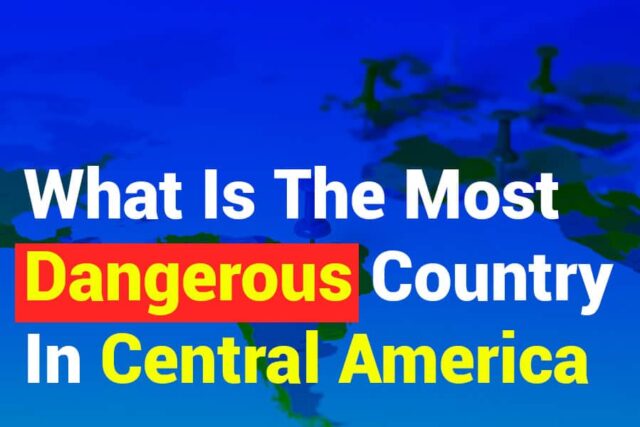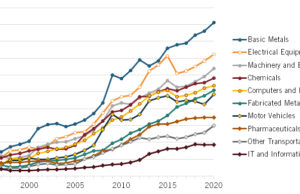Central America is a region of incredible beauty, cultural richness, and diverse attractions. However, it also faces significant challenges related to crime, violence, and political instability. For travelers and those considering relocating, the question often arises: What is the most dangerous country in Central America?
Understanding safety concerns in this region involves analyzing various factors, including crime rates, socio-political conditions, and economic instability. Countries like Honduras, El Salvador, and Guatemala frequently top the list for high homicide rates and gang-related violence. These issues are often tied to systemic challenges, such as poverty, corruption, and limited access to education and employment.
What is the most dangerous country in Central America?
Honduras is often cited as the most dangerous country in Central America due to its high crime rates, particularly related to gang violence and homicides. The cities of Tegucigalpa and San Pedro Sula are notable hotspots for crime. Factors like poverty, political corruption, and weak law enforcement contribute to the instability. However, El Salvador and Guatemala also face significant safety challenges, including gang-related activities and socio-economic issues. While these risks are serious, tourists can take precautions, such as avoiding high-risk areas and staying informed, to explore Central America safely.
What Is the Most Dangerous Country in Central America?
Central America is a region of contrasts, with breathtaking landscapes and rich cultural heritage juxtaposed against high crime rates and safety concerns. Honduras is often considered the most dangerous country in the region, with staggering homicide rates and pervasive gang violence. Cities like San Pedro Sula and Tegucigalpa are known for their high levels of crime, often linked to drug trafficking and organized gangs.
El Salvador is another country that faces similar challenges, particularly with the presence of gangs like MS-13. Despite recent government efforts to reduce crime, the country continues to struggle with safety concerns. Guatemala, too, deals with a range of issues, from violent crime to systemic corruption, further contributing to its reputation as a high-risk destination.
Understanding what is the most dangerous country in Central America requires examining the socio-economic and political factors driving these safety concerns. Issues like poverty, unemployment, and lack of access to education exacerbate criminal activity, making it crucial to address these root causes.
Factors Contributing to Safety Risks in Central America
High Crime Rates
Honduras and El Salvador are often at the forefront of discussions about crime in Central America due to their alarmingly high homicide rates. These figures are largely driven by gang violence and the pervasive influence of drug trafficking networks. The presence of groups like MS-13 and Barrio 18 exacerbates the risks, as they dominate local communities, engaging in extortion, kidnappings, and violent clashes. This high level of crime has deeply impacted the daily lives of residents and created a sense of fear and instability within these nations.
Political Instability
Political instability is a significant contributor to safety concerns in Central America. Weak governance, rampant corruption, and inconsistent enforcement of laws undermine efforts to establish secure environments. Governments often struggle to implement long-term strategies for reducing crime, and corruption within political systems further hampers progress. Political unrest and frequent leadership changes create additional uncertainty, making it challenging to address the root causes of violence and instability.
Economic Challenges
Economic hardship is another factor fueling crime in Central America. Widespread poverty and high unemployment rates leave many citizens vulnerable to exploitation by criminal organizations. With limited access to legitimate income opportunities, individuals may turn to illegal activities as a means of survival. These economic struggles perpetuate cycles of violence, as criminal networks take advantage of the desperation and vulnerability that poverty creates.
Ineffective Law Enforcement
Law enforcement agencies in many Central American countries face significant challenges, including underfunding, corruption, and a lack of resources. These issues hinder their ability to combat crime effectively and provide protection for citizens. Corruption within police forces and judicial systems further erodes public trust, making it difficult to establish a reliable framework for justice and accountability.
Social Inequality
Social inequality is a persistent issue that exacerbates instability in the region. Disparities in wealth, education, and access to basic resources create environments where crime can thrive. Marginalized communities, in particular, are often left without support, making them more susceptible to gang recruitment and violence. Addressing these inequalities is essential for reducing the societal instability that fuels high crime rates in Central America.
How Dangerous Countries Affect Travelers and Locals
Tourism Decline: High crime rates significantly deter international tourists from visiting Central America, particularly countries like Honduras and El Salvador. Tourism, a vital source of income for many regions, suffers as safety concerns overshadow the natural beauty and cultural richness these countries offer. This decline in visitors has a direct impact on local economies, reducing income for businesses reliant on tourism, such as hotels, restaurants, and tour operators.
Daily Life Risks: For locals, the risks associated with daily life in high-crime areas are profound. Gang extortion is a common occurrence, forcing many families and small businesses to pay “protection fees” to avoid violence. Additionally, unsafe neighborhoods and frequent incidents of theft, assault, and kidnappings create a constant sense of fear and insecurity. This atmosphere impacts community life, limiting opportunities for economic and social development.
Economic Impact: Violence and instability in Central America discourage foreign investment and stunt economic growth. Investors often shy away from regions with high crime rates, fearing losses due to insecurity or the inability to maintain stable operations. This lack of investment exacerbates existing economic challenges, including unemployment and poverty, creating a vicious cycle where instability continues to grow. Furthermore, businesses within these countries face increased operational costs related to security and protection measures.
Migration Trends: The ongoing violence and lack of opportunities force many Central Americans to leave their home countries in search of safety and stability. Migration, particularly to the United States, has become a survival strategy for thousands of families fleeing gang violence, extortion, and political instability. While this provides temporary relief for individuals, it places strain on both the migrants and the countries they move to, as well as leaving their home nations with a depleted workforce and talent pool.
These challenges underscore the far-reaching consequences of crime and instability in Central America, affecting not only the region’s safety and economy but also its social and cultural fabric.
Practical Tips for Staying Safe in Central America
Traveling in Central America can be a rewarding experience, but safety should always be a top priority, especially when considering what is the most dangerous country in Central America. Staying informed and taking the right precautions can help you navigate the region safely while enjoying its beauty and culture.
Researching your destinations thoroughly is an essential first step. Familiarize yourself with the areas you plan to visit and avoid high-risk neighborhoods or cities known for crime, such as certain parts of Tegucigalpa or San Salvador. Opt for guided tours or trusted transportation providers, as they can offer a safer and more organized way to explore. Local guides are often well-versed in safety protocols and can help you steer clear of potentially dangerous situations.
While exploring, remain vigilant and aware of your surroundings at all times. Keep your valuables secure and avoid displaying wealth, such as wearing expensive jewelry or using high-end gadgets in public. These items can attract unwanted attention, particularly in areas where economic disparities are prevalent. Use discreet methods to carry your belongings, such as money belts or anti-theft bags, to further reduce risks.
Another key safety measure is staying connected. Share your travel itinerary with friends or family members and check in regularly to ensure they know your location. Having a local SIM card or access to reliable internet can be invaluable for maintaining communication and accessing emergency services if needed.
Lastly, respecting local customs and adhering to travel advisories can go a long way in ensuring a safe journey. Many safety risks can be mitigated by understanding and observing cultural norms, such as dress codes and behavioral expectations. Paying attention to government travel advisories for updates on political or social unrest is also crucial.
When considering what is the most dangerous country in Central America, preparedness and awareness are your best tools for minimizing risks and enjoying a safe and enriching experience. With careful planning and mindfulness, you can explore Central America’s rich history, vibrant culture, and breathtaking landscapes without compromising your safety.
Why Understanding Regional Safety Is Important?
Travelers’ Perspective
Understanding what is the most dangerous country in Central America is crucial for tourists who wish to explore the region safely. This knowledge allows travelers to make informed decisions when planning their itineraries, helping them avoid high-risk areas while still experiencing the cultural and natural beauty the region has to offer. By researching potential destinations and assessing the safety of specific cities or neighborhoods, tourists can enjoy their trips with greater peace of mind. Awareness of local safety conditions empowers visitors to take precautions, such as choosing guided tours, trusted accommodations, and secure transportation options, ensuring a memorable and safe travel experience.
Policy and Development
Highlighting the safety concerns in Central America brings attention to the urgent need for policy reforms and international support. Many of the challenges that contribute to danger in these countries, such as gang violence, poverty, and ineffective governance, require comprehensive solutions. Addressing these issues involves collaborative efforts from both local governments and global organizations. When the spotlight is placed on safety concerns, it creates a platform for dialogue and action, encouraging initiatives that focus on education, economic opportunities, and stronger law enforcement. These reforms can ultimately lead to improved living conditions for local communities and a safer environment for visitors.
Awareness and Advocacy
Raising awareness about the challenges faced by Central America’s most dangerous countries can inspire advocacy and aid initiatives aimed at creating lasting change. When people around the world understand the root causes of instability—such as social inequality, economic hardship, and corruption—they are more likely to support efforts to address these issues. Advocacy can take many forms, from volunteering and donating to supporting policies that prioritize humanitarian aid and development projects. Increased awareness also fosters empathy and understanding, breaking down stereotypes and highlighting the resilience and potential of the region’s people. By shining a light on these challenges, the global community can contribute to building a safer, more prosperous future for Central America.
In Closing
Determining what is the most dangerous country in Central America requires a nuanced understanding of the region’s socio-political and economic challenges. Honduras often ranks as the most dangerous due to its high crime rates and gang activity, but El Salvador and Guatemala also face significant safety concerns. Despite these challenges, taking precautions and staying informed can allow both locals and travelers to navigate the region safely. Understanding these risks is crucial for addressing systemic issues and fostering a safer, more prosperous Central America.
FAQ’s
Q. Which country has the highest crime rate in Central America?
A. Honduras is widely regarded as having the highest crime rate, with significant issues tied to gang violence and drug trafficking.
Q. Is it safe to travel to Central America?
A. While some areas pose risks, many destinations in Central America are safe for tourists who take precautions, such as avoiding high-crime areas.
Q. What measures are being taken to reduce violence in Central America?
A. Efforts include government initiatives to combat gangs, international aid programs, and reforms aimed at improving law enforcement and education.
Q. What are the safest countries in Central America?
A. Costa Rica and Panama are often considered the safest countries in the region due to their lower crime rates and stable political environments.
Q. How can travelers stay safe in Central America?
A. Researching destinations, avoiding risky areas, using trusted transportation, and staying aware of surroundings are key steps to staying safe.














